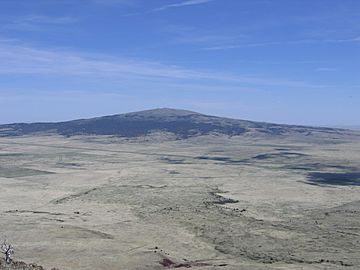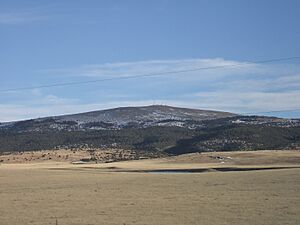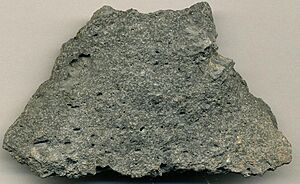Sierra Grande facts for kids
Quick facts for kids Sierra Grande |
|
|---|---|

Sierra Grande seen from the top of Capulin Volcano.
|
|
| Highest point | |
| Elevation | 8,723 ft (2,659 m) NAVD 88 |
| Prominence | 1,880 ft (570 m) |
| Geography | |
| Location | Union County, New Mexico, U.S. |
| Topo map | USGS Capulin |
| Geology | |
| Mountain type | Stratovolcano |
| Volcanic field | Raton-Clayton volcanic field |
| Climbing | |
| Easiest route | Hike |
Sierra Grande is a very old, extinct stratovolcano in northeastern New Mexico. It stands about 2,200 feet (670 meters) above the land around it. This volcano is part of the Raton-Clayton volcanic field, which is no longer active.
Where is Sierra Grande?
On a clear day, you can see Sierra Grande from far away. It is visible from Texline, Texas, and even from the tops of the Culebra Range in southern Colorado and northern New Mexico.
The eastern side of Sierra Grande is a special place. It is the easternmost spot in the United States that is more than 8,000 feet (2,438 meters) above sea level. The very top of Sierra Grande is also the highest point in the United States east of the 104 degrees west line of longitude.
Important roads and a railway run near the volcano. U.S. Highway 64, U.S. Highway 87, and the Colorado and Southern Railway are to the north and east. The small town of Des Moines is just northeast of the volcano. To the northwest, you can find Capulin Volcano National Monument. This park features Capulin Volcano, which is another extinct volcano in the Raton-Clayton volcanic field.
How Sierra Grande Formed
Sierra Grande is the biggest volcano in the Raton-Clayton volcanic field. Its lava flows happened a long time ago, between 3.8 and 2.6 million years ago.
Most of the volcano is made of a type of rock called andesite. This specific kind of rock is very rare in other parts of the Raton-Clayton volcanic field.



